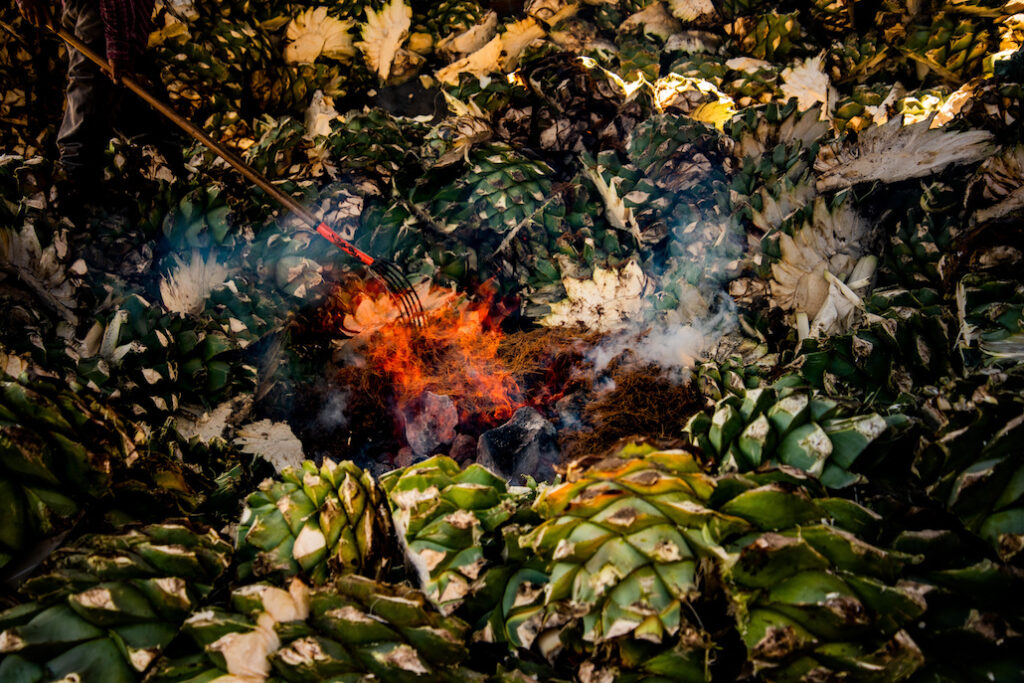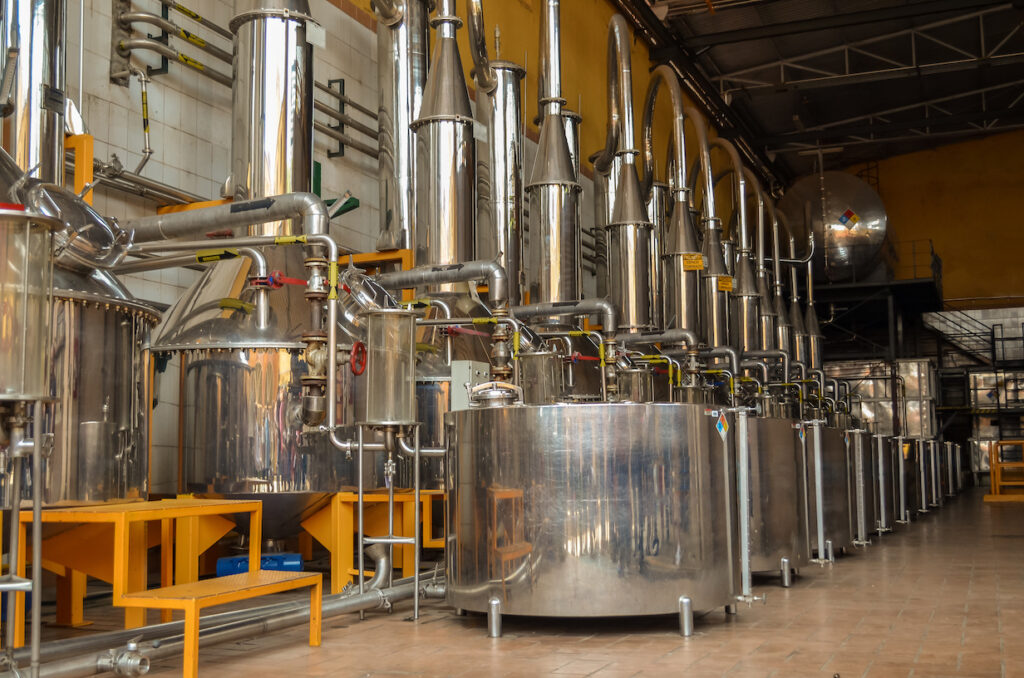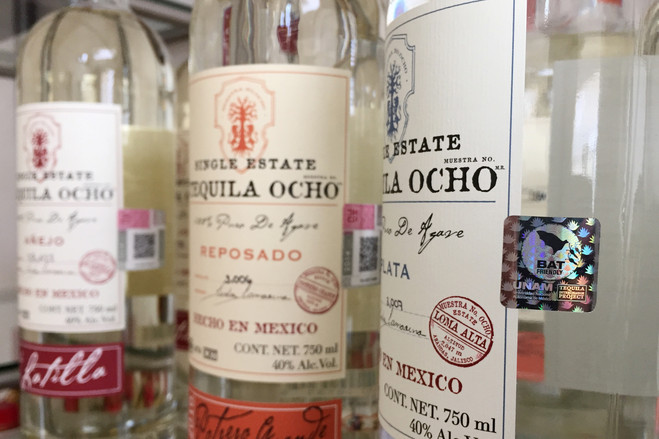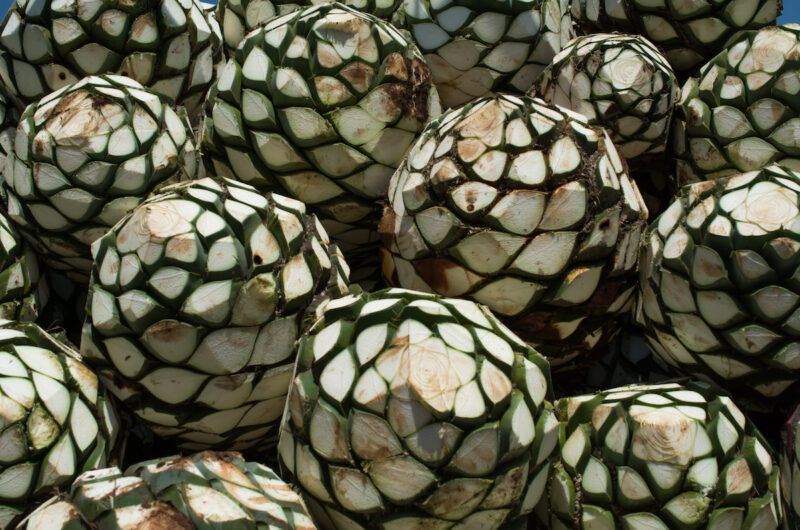Mezcal is growing wildly popular in the United States and abroad. Even within Mexico, where the spirit originated, it’s reputation has done an about face recently. What used to be a niche spirit that was looked down upon as tequila’s odd little brother, mezcal is now fully mainstream, and it’s deservedly earning massive respect around the globe.
Today, you’ll find creative mezcal based cocktails on the menus of the hottest bars around the world. Ten years ago, that was much less certain, and twenty years ago, that was completely unheard of. Despite the bad rap, mezcal and tequila are produced from the same plant – agave. Unique cultivation processes differentiate the two agave spirits from one another, but otherwise, they are very much the same family. If anything, tequila is more mezcal than mezcal is tequila. Tequila can only be made from one specific variety of agave (blue weber) whereas mezcal can be made from almost any variety of agave – and commercially 30-40 varieties are commonly used. On a sales volume basis, mezcal is still in tequila’s shadow, but that’s changing quickly. Mezcal is the fastest growing spirit in the world, and it’s driving the agave family forward.
According to the IWSR, sales volume of mezcal grew in the United States by nearly 50% in 2019 and 15% in 2020. The mezcal industry is predicted to continue growing at a rate (Compound Annual Growth Rate based on revenue) of 22.60% between now and 2031. That’s staggering. For comparison’s sake, the beer industry is expected to grow at a rate (CAGR) of 5.44% over the next five years, and the vodka industry by 5.50% over the same period of time. The tobacco industry is heading in the opposite direction, with expected growth rates of 2.40% over the next 10 years. To put all of these figures into perspective, the International Monetary Fund projects the global GDP to hover around 3% and that of advanced countries just below 2% over the next five years and beyond. In layman’s terms, that means the tobacco industry is at best keeping pace with the global GDP while the industries of beer and other alcoholic beverages are growing just above the global GDP. Mezcal is absolutely crushing the curve.
If you’re not a numbers person and you skimmed ahead to this part, just know this: mezcal is growing at an unparalleled rate among its peers. Expect to see more and more mezcal in liquor stores, in pop culture, and on restaurant and cocktail bar menus in the many years to come. Mezcal is for real, and it’s here to stay.
What is mezcal? How does it differ from tequila?
Mezcal has come a long way from the days of being known as a “poor man’s drink”. Sharing the same origin of tequila – agave – mezcal has long been looked upon as the dominant spirit’s oddball half-brother. Mezcal was a drink for the masses, as it could be created in any condition from any agave species. It became largely associated with lower class citizens across Mexico. It’s a shame for those who looked down upon mezcal in the past, because it’s a wonderful spirit, with more vibrancy than tequila. Mezcal’s unique smokey flavor and strong alcohol profile makes it a favorite among creative bartenders. Chefs like it too. The flavor profile holds up well in marinating, grilling, and roasting various meats and seafood. The variation of mezcal can take fans of it on a near never ending tasting journey. Akin to wine, mezcal offers nuanced flavor profiles from production to production based on the type of agave used and the conditions of where it was grown.
While tequila must be made from one specific type of agave – blue weber – mezcal can be made commercially well from at least 30 different varieties of agave. The production of both mezcal and tequila begin with the cultivation of the piña, the core of the agave plant, also known as the “head”. The piñas are removed, cooked, and then ground to release the plant’s natural juices. With respect to mezcal, the piña is roasted in large stone ground or earthen pits and over fire. This is where mezcal’s distinct smoky flavor comes from. Tequila production on the other hand is much more modernized and automated. The piñas are often steamed, which lends itself to a smoother and more refined flavor compared to mezcal. Yeast is then added to the agave sugars and fermented into alcohol. The alcohol is further distilled, often in stills or even oak barrels, until it reaches the final product. Depending on the cultivation and cooking method used, the final product is either mezcal or tequila.

Why did mezcal become so popular?
Prior to 1994, there were virtually no regulations surrounding mezcal production in Mexico. Any mezcal of any age could be sold largely without any oversight. This naturally led to widespread quality issues that garnered mezcal a rather unpleasant reputation for much of its existence – a “poor man’s drink”. There wasn’t much of a market for the spirit anyway. Things began to change though, when in 1997 the Official Mexican Standards (NOM) were put into place. Mezcal production was fully regulated and certified by 2005, when these standards would become law. Given the luxury of hindsight, this could easily be considered the beginning of the mezcal craze.
The developments in 2005 caught the attention of entrepreneurs and investors across North America, and they began to enter the ripe market. Since then, twelve large scale production facilities have been built, and the Oaxaca state government has invested millions of dollars on marketing campaigns based entirely around mezcal. New demand was created for mezcal, and once it caught on, it caught on.
It would be remiss not to mention that the state of Oaxaca is one of the poorest in Mexico. And to consider that the government is spending serious money on advertising mezcal, that sounds a bit counterintuitive, doesn’t it?
Either way, it’s working. Travel + Leisure’s readers named Oaxaca (the capital city of the eponymously named state), the “best city in the world”… In the world. It beat out a lot of cities. Nobody would have thought about vacationing in Oaxaca a mere decade or two ago, and now luxury resorts and distilleries are popping up like it’s Napa Valley. Don’t get me wrong. That’s great for the readers of Travel + Leisure magazine, but what about the people living and working in Oaxaca? How have they benefited from the state’s tourism boom? Surely they must have, right?
Well, the answer is not that cut and dry. The mezcal driven tourism boom has had both positive and negative impacts on the state of Oaxaca, but trickle down economics have proved over time that it doesn’t work for those on the bottom. Foreign interest and government sponsored ad campaigns aren’t entirely equivalent to trickle down economics, but the point I’m getting at is the same. Who benefits from those government sponsored ad campaigns, foreign investment, and new development the most? Methinks foreign investors, local business owners, government officials, and most notably, tourists benefit the most. Or in other words, those currently toward the top of the pyramid benefit the most from Oaxaca’s tourism boom.
Infer from that information what you will.
What regulations are there on mezcal?
There are two primary goals with respect to laws and regulations surrounding mezcal production: 1) to ensure consistent quality overall and 2) respect artisanal production methods. Both are critically important for the growth of the mezcal industry. Deviations in overall quality largely contributed to mezcal’s less than ideal initial reputation. Because mezcal can be produced using many different varieties of agave and in any condition, the spectrum of quality and flavor ranges much wider than with any other spirit. This should be a strength of mezcal and not a weakness, like it had been for far too long. Requiring that artisanal, or in other words, by hand, production methods be followed, mezcal’s authenticity is ensured. It’s the latter aspect, in my opinion, that’s driving consumer demand, particularly within the United States, for mezcal more than anything.
More specifically, the standards require that mezcal must be bottled at the point of origin, can’t be shipped in bulk with other spirits, and must be sweetened naturally, entirely from the agave plant. Any variety of agave can be used for mezcal production as long as it’s grown in designated Denomination of Origin regions, which are: Oaxaca, Guerrero, Guanajuato, Michoacán, Zacatecas, San Luís Potosí, Tamaulipas, Durango and Puebla. Approximately 90% of mezcal comes from Oaxaca.
The standards further break down mezcal production into three categories: mezcal, artisanal mezcal, and ancestral mezcal. Ancestral mezcal standards are the strictest and least practiced. Most mezcal is artisanal mezcal, which must be made following traditional methods. Regulations allow for some variety in the traditional methods one can choose from, particularly with regard to the fermentation process. To be considered basic mezcal, producers are allowed to use equipment outside of the traditional methods, like an autoclave. This is the point at which any artisanal aspects are lost, and quite frankly, we as consumers shouldn’t be drinking or purchasing much, if any, of this type of mezcal. The rapid growth of mezcal is not without risk, and mechanizing the production of it is an anti-solution to the problems currently being posed upon the industry.

What risks are associated with the massive growth of mezcal?
The problem with mezcal’s popularity arises within the spirit’s greatest strength: it’s artisanal aspect. The definition of artisanal is literally: “of a product, especially food or drink made in a traditional or non-mechanized way“. That also translates to “it’s going to take a while“. And there in lies the problem. How can you quickly scale an artisanal product and keep it artisanal? The rapid growth of the mezcal industry is proving that it’s hard to do just that.
Certain varieties of agave used in the production of mezcal can take up to 25 years to grow to maturity. That means that producers of mezcal are already starting off at a disadvantage against time. As a producer, you wait a fraction of a generation for your crop to grow and you still can’t use machines to finish the process? You’re probably starting to see part of the problem by now.
Even some of the fastest growing agave varieties can take up to 7 years to reach maturity. There’s really no way around the time it takes to grow agave without harvesting the crop prematurely – and that presents a huge threat to the natural reproduction of wild agave. Growing more crop is a theoretical solution, but it’s not viable for the long term well being of mother nature. Farmland is already chewing up vast acreage of the earth’s surface, and that’s presenting massive ecological challenges that we’ve yet to face.
Fortunately, there are advocacy groups doing their part to promote sustainability and conservation with mezcal and tequila production. The Bat Friendly Project is a Mexico based advocacy group championing the use of bats as part of the solution toward sustainable agave harvesting. Agave plants naturally reproduce by flowering and releasing seeds into the air. However, harvesting them prematurely prevents the plants from flowering. Producers’ efforts to speed up the production time inherently poses a direct risk to the natural reproduction of agave. It’s like digging your own future grave because it’s good business right now.
Alas, the bats. The Bat Friendly Project advocates for producers to allow just 5% of their crop to reach maturity and allow bats to pollinate the rest of the land. Bats rapidly cross-pollinate agave plants, mimicking the environment as if the entire crop had reached maturity and been allowed to naturally reproduce. The efforts are two-fold in that these efforts also help protect the natural bat population. If producers meet Bat Friendly production standards, they can be certified as such. This not only helps sustainable producers stand out, but it also helps consumers make informed purchases. The latter is equally, if not more important in influencing sustainable practices. Consumers have the greatest power in this dynamic, that is, the right to support sustainable businesses.
When I reference consumers, I’m including bar, restaurant, and retail owners, all of whom have critical influence over individuals.

How can consumers ensure sustainable growth of the mezcal industry?
Producers are always going to look for ways to economize production of their goods. It’s just good business practice. That is, until, it isn’t. Until they’re incentivized not to.
Mezcal shouldn’t be a commodity. It shouldn’t be compared with other mass produced spirits. It should be featured independently in liquor stores and featured like wine on mens. Accept and respect the fact that mezcal production takes time. A lot of it too. Naturally prices are going to be higher, and we all should be okay with that. Consumers shouldn’t shop mezcal on price, but rather based on quality, origin, and characteristics. There’s a story behind every bottle. Mezcal should be considered a luxury good. There should be a bottom price of doing business. Support small producer-owners over venture capitalist backed foreign brands. Look for the Bat Friendly Certification and choose from there. The movement towards sustainability can and should start with the consumer – not a VC boardroom.
So, go get yourself some sustainably sourced mezcal and get to drinking… or cooking!


Pingback: Creamy Mezcal, Bacon & Roasted Tomato Linguine - He Cooks